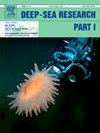日本海沟和千岛-堪察加海沟最南端的深海和赤潮片足类科和属的水深分布
IF 2.1
3区 地球科学
Q2 OCEANOGRAPHY
Deep-Sea Research Part I-Oceanographic Research Papers
Pub Date : 2025-02-01
DOI:10.1016/j.dsr.2024.104438
引用次数: 0
摘要
片足动物属于超纲片足动物,是分布在多个深度带的底栖动物群中占有显著比例的动物。为了了解底栖生物的组成和分布,特别是在西北太平洋地区,已经进行了广泛的采样。然而,后勤方面的挑战和有限的机会限制了我们对底栖动物多样性和分布的了解。使用两种类型的拖网和一个底栖雪橇,在日本海沟和千岛-堪察加海沟的55个采样点收集了深海和深海底栖动物,深度在3689米至8010米之间。两次考察共采集了3126只深海片脚类动物,并将其归属于37科至少76属。丰度由高到低依次为Phoxocephalidae, Ampeliscidae, Lysianassoidea和oedierotidae。此外,还鉴定出了大量的潜蝇科、潜蝇科、潜蝇科和潜蝇科属。在两个海沟中,属数均与深呈弱的负相关关系。片足类的多样性和丰度在向陆坡区最高,而在海沟轴区最少。高生产力,加上邻近日本群岛,可能解释了我们研究区域观察到的片脚类组合特征。我们的发现提供了全球深度记录的新数据,包括8个已确定的和1个未确定的片脚类属,属于9科。本文章由计算机程序翻译,如有差异,请以英文原文为准。
Bathymetric distribution of abyssal and hadal amphipod families and genera in the Japan Trench and the southernmost Kuril-Kamchatka trench
Amphipoda, belonging to superorder Peracarida, represents a conspicuous proportion of benthic fauna occurring across multiple depth zones. Extensive sampling has been conducted to understand the composition and distribution of benthic organisms, particularly in the Northwest Pacific. However, logistical challenges and limited opportunities have restricted our understanding of benthic fauna diversity and distribution. Using two types of trawls and an epibenthic sledge, abyssal and hadal benthic fauna were collected across 55 sampling sites from both the Japan Trench and the Kuril-Kamchatka Trench, at depths between 3689 m and 8010 m. A collection of 3126 deep-sea amphipods was obtained and the animals were assigned to at least 76 genera belonging to 37 families during the two expeditions. The most abundant family was Phoxocephalidae, followed by Ampeliscidae, Lysianassoidea and Oedicerotidae in descending order of abundance. In addition, high numbers of genera of the Pardaliscidae, Oedicerotidae, Stegocephalidae and Synopiidae families were identified. In the two trenches, the number of genera showed a weak inverse correlation with depth at both abyssal and hadal depths. Amphipod diversity and abundance were highest in the landward slopes, whereas those observed in the trench axes were the least diverse and abundant. High productivity, in addition to proximity to the Japanese archipelago, may explain the amphipod assemblage characteristics observed in our study areas. Our findings present novel data on the global depth records for eight identified and one unidentified amphipod genera, belonging to nine families.
求助全文
通过发布文献求助,成功后即可免费获取论文全文。
去求助
来源期刊
CiteScore
4.60
自引率
4.20%
发文量
144
审稿时长
18.3 weeks
期刊介绍:
Deep-Sea Research Part I: Oceanographic Research Papers is devoted to the publication of the results of original scientific research, including theoretical work of evident oceanographic applicability; and the solution of instrumental or methodological problems with evidence of successful use. The journal is distinguished by its interdisciplinary nature and its breadth, covering the geological, physical, chemical and biological aspects of the ocean and its boundaries with the sea floor and the atmosphere. In addition to regular "Research Papers" and "Instruments and Methods" papers, briefer communications may be published as "Notes". Supplemental matter, such as extensive data tables or graphs and multimedia content, may be published as electronic appendices.

 求助内容:
求助内容: 应助结果提醒方式:
应助结果提醒方式:


